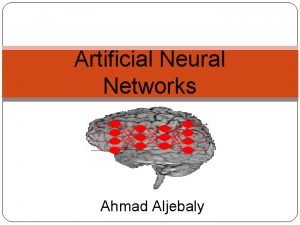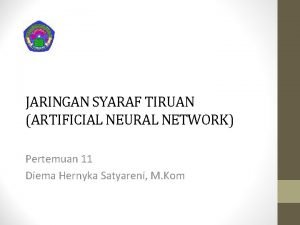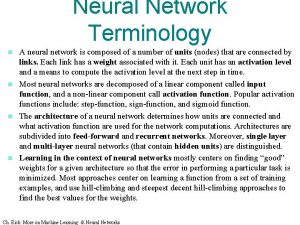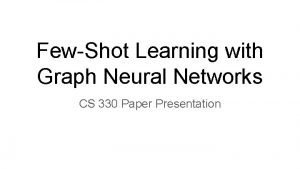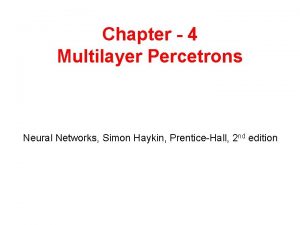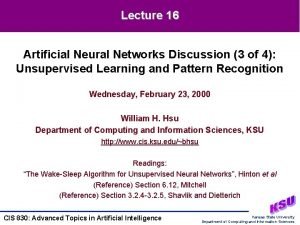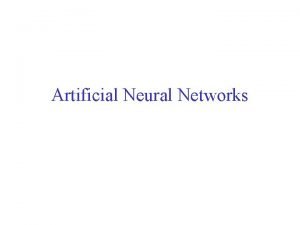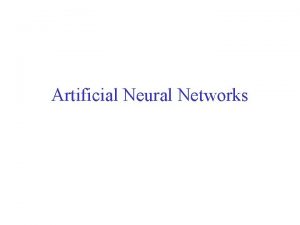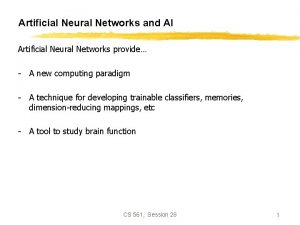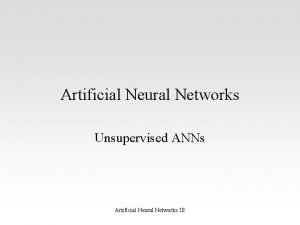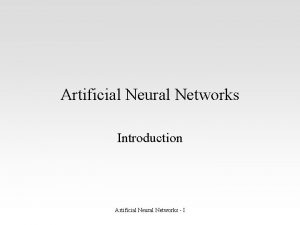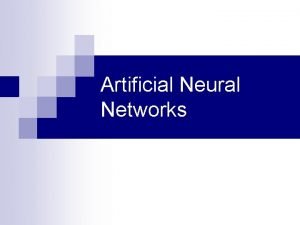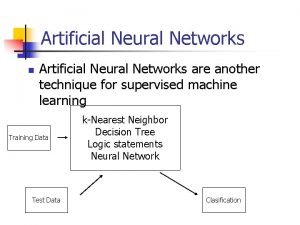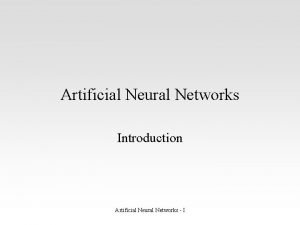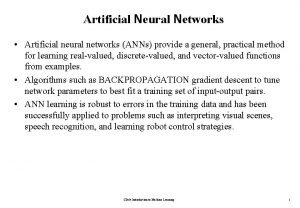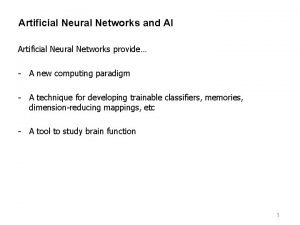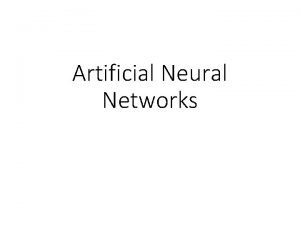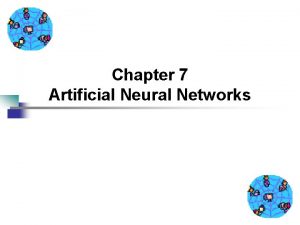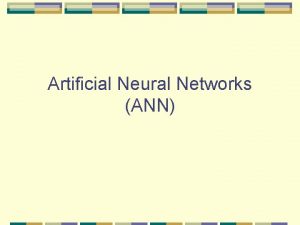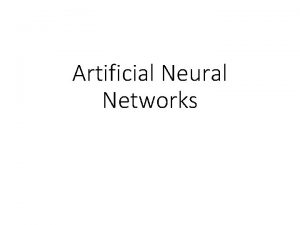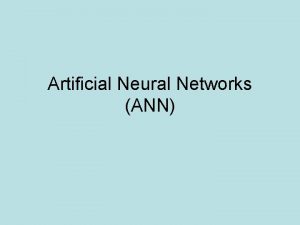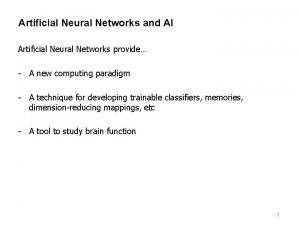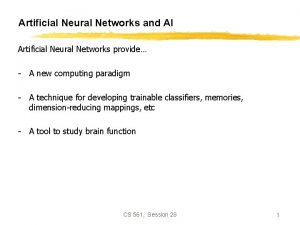ARTIFICIAL NEURAL NETWORKS Single Layer of Neurons Single




















- Slides: 20

ARTIFICIAL NEURAL NETWORKS Single Layer of Neurons (Single Layer Neural Network) 1

ARTIFICIAL NEURAL NETWORKS Single Layer of Neurons A single neuron with unit step activation function can classify the input into two categories A A=0 B=1 B 2

ARTIFICIAL NEURAL NETWORKS Single Layer of Neurons However, we can also use one neuron to classify only one class. The neuron decides whether the input belongs to its class or not This configuration has the disadvantage that the network size become large However, it has the advantage that an input may be placed in more than one class, or in none of the classes. 3

ARTIFICIAL NEURAL NETWORKS Single Layer of Neurons Two neurons for two categories A=1 A = 0 B=1 B=0 A B B A B A 4

ARTIFICIAL NEURAL NETWORKS Single Layer of Neurons Two neurons with unit step activation function can classify the input into four categories 00 A=0 B=1 10 01 11 5

ARTIFICIAL NEURAL NETWORKS Single Layer of Neurons For single layer neurons, each neuron of the network can be considered as an independent neuron 6

ARTIFICIAL NEURAL NETWORKS Single Layer of Neurons Four neurons for four categories A=1 A A=0 C=1 B C D B=1 D=1 7

ARTIFICIAL NEURAL NETWORKS Single Layer of Neurons A single layer of neurons cannot classify the input patterns that are not linearly separable To be able to learn such functions, neurons are required to be arranged in two or more layers 8

ARTIFICIAL NEURAL NETWORKS Example: Character Recognition 9

ARTIFICIAL NEURAL NETWORKS Single Layer Network Example: Character Recognition Consider that we have some input patterns of the letter “A” and others of not “A” The patterns belong to different fonts We train a neuron to classify each of these vectors as belonging, or not belonging, to the class “A” (1 or -1) There are 3 examples of “A” and 18 examples of not “A” 10

ARTIFICIAL NEURAL NETWORKS Single Layer Network 11

ARTIFICIAL NEURAL NETWORKS Single Layer Network We can use the same training samples as examples of B and not B, and train another neuron in a similar manner Note that the weights of the neuron for “A” have no interaction with the weights for the neuron for “B” Therefore, we can solve these two problems at the same time by having 2 neurons Continuing with this idea, we can have 7 neurons, one for each category 12

ARTIFICIAL NEURAL NETWORKS Single Layer Network 13

ARTIFICIAL NEURAL NETWORKS Activation Functions Linear Function y = f(act) = γ * act The neuron output is simply equal to the weighted sum of the inputs. It may be modulated by a constant factor γ 14

ARTIFICIAL NEURAL NETWORKS Activation Functions 15

ARTIFICIAL NEURAL NETWORKS Activation Functions Step Function y = f(act) = 1 = 2 If act ≥ 0 If act < 0 For the step function only one of the two scalar values are possible at the output Usually ( 1, 2) are taken as (1, -1) or (1, 0) 16

ARTIFICIAL NEURAL NETWORKS Activation Functions Sigmoid Function (Logistic function) y = f(act) = 1 1 + e– λ(act) The sigmoid function is a continuous version of the ramp function The parameter λ controls the steepness of the function. Large λ makes it almost a unit step function. Usually λ = 1 17

ARTIFICIAL NEURAL NETWORKS Activation Functions Hyperbolic Tangent Function y = f(act) = = eλ(act) - e– λ(act) eλ(act) + e– λ(act) 2 1 + e– λ(act) -1 The output of this function is in the range (-1, 1) 18

ARTIFICIAL NEURAL NETWORKS Activation Functions Ramp Function mxzc y = f(act) = = act = - If act ≥ If - < act < If act ≤ - It is a combination of the linear and step functions 19

ARTIFICIAL NEURAL NETWORKS Activation Functions Gaussian Function y = f(act) = e-θ where θ = (act)2/ 2 Where 2 is the variance of the Gaussian distribution 20
 Pigmented layer and neural layer
Pigmented layer and neural layer Conclusion neural network
Conclusion neural network Pengertian artificial neural network
Pengertian artificial neural network Artificial neural network in data mining
Artificial neural network in data mining Neural network terminology
Neural network terminology Neural networks and learning machines 3rd edition
Neural networks and learning machines 3rd edition Lateralization
Lateralization Few shot learning with graph neural networks
Few shot learning with graph neural networks Perceptron xor
Perceptron xor Efficient processing of deep neural networks
Efficient processing of deep neural networks The wake-sleep algorithm for unsupervised neural networks
The wake-sleep algorithm for unsupervised neural networks Fuzzy logic lecture
Fuzzy logic lecture Matlab neural network toolbox
Matlab neural network toolbox Deep forest towards an alternative to deep neural networks
Deep forest towards an alternative to deep neural networks Audio super resolution using neural networks
Audio super resolution using neural networks Lstm andrew ng
Lstm andrew ng Sparse convolutional neural networks
Sparse convolutional neural networks Deep neural networks and mixed integer linear optimization
Deep neural networks and mixed integer linear optimization Audio super resolution
Audio super resolution Introduction to convolutional neural networks
Introduction to convolutional neural networks Visualizing and understanding convolutional networks
Visualizing and understanding convolutional networks

